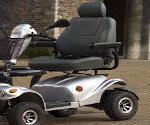[toc]
If you’ve just got yourself a new battery for your mobility scooter and are wondering what to do with the old one then you’ve come to the right place. We’ve done the research on your different options for disposal and here’s what we discovered.
Mobility scooter batteries have a number of dangerous ingredients and the best way to dispose of them is to drop them off at a professional battery recycling centre near you. See below for links to your closest location.
Continue reading to learn about the different types of batteries used in the most popular mobility scooters and what you need to know about each of them.

The Different Types of Mobility Scooter Batteries
When Allessandro Volta built the world’s first electric battery in 1799, he used alternating discs of copper and zinc as electrodes stacked as a tower. Then he separated these with cloth soaked in brine. The materials Volta chose were chemically inert and completely safe. Napoleon summoned him to Paris to receive a special award.
Modern batteries also comprise electrodes made from base metals, but these are coated with rare, expensive compounds. Moreover, their electrolytes may be corrosive, flammable or both. Mobile scooter owners should therefore dispose of their batteries safely, and in ways that encourage recycling of their materials.
Lithium-Ion Batteries
Lithium-Ion batteries use lithium metal as their active ingredient to release the energy that drives the scooter. Manufacturers add rare, expensive cobalt metal to control the unstable lithium, and use a highly volatile electrolyte to manage the cycle.
Lithium-ion batteries are expensive per unit of weight, but compress a large amount of energy into small space. They need careful handling at the end of their life when the components wear out, and they can overheat if mishandled.
AGM Deep Cycle Batteries
Absorbent glass-mat batteries are sealed lead-acid batteries following Volta’s original design. They use diluted sulfuric acid as their electrolyte, but contain this in a very fine fiberglass mat making them spill proof. This enables them to tolerate a high rate of discharge.
Their stable construction makes recycling their lead plates quick and simple. However, they are heavier than lithium-ion ones. This weight disadvantage creates the gap in the market lithium-ion fills.
Mobility Scooter – Infographic

VRLA Gel Batteries
Gel batteries are of similar construction to AGM deep cycle batteries, and are also sealed for life. However their acid electrolyte is compounded with silica forming a thick, putty-like gel.
This design makes them resistant to shock, vibration and corrosion, while costing less than AGM deep cycle ones. However, they don’t last as long as AGM ones do. But both types do have the advantage of being sealed, and able to function when not upright.
Basic Lead-Acid Batteries
Basic lead-acid batteries use a liquid sulfuric-acid electrolyte to surround the lead plates, and regulate a controlled chemical reaction. A small amount of hydrogen gas releases through the vented caps when recharging.
Several constraints apply to these shorter-life lead-acid batteries. They must be recharged in a well-ventilated space, they need regular topping up, and they must be kept upright at all times. Moreover, if the case cracks open after an impact, raw acid flows out.
How to Properly Dispose of Batteries
We’re not sure how many batteries of all types the world makes every year. Although we would not be surprised if this was as many as there are people on earth. Electric batteries come in a myriad of different shapes, but they all have several things in common.
The materials that battery manufacturers use are not in infinite supply. We should use them sparingly. Imagine a life without batteries! Much energy is consumed extracting the raw material from the earth and refining it. Batteries add to the rate of global warming. If we scrap old batteries and bury them as landfill then we have to start all over again with the process of mining and refining.
We avoid this when we recycle the materials for repeated reuse. Moreover, we no longer pollute earth with chemicals leaching out from corroded batteries.
These principles apply to each of the four mobility scooter battery types. We should therefore properly dispose of used ones, so we contribute towards creating a better world. This also keeps the cost of replacement batteries lower.
FAQ
Where can I recycle mobility scooter batteries?
If you’re in the US you’ll find a drop-off location finder here. If you’re in Australia then Battery World offer a free recycling service nation wide.
Can I put batteries in the recycle bin?
In a few words this depends on which recycle bin we are thinking of. They should never be put in your home recycling bin. Batteries need to follow a dedicated recycling path, because of the value of their components and the dangerous nature of some of their materials.
Used mobility scooter batteries therefore need to enter a dedicated recycling chain as early as practical. The simplest and easiest thing is to hand them at the place where you sourced the replacement ones. If you have this done at a fitment centre they have a legal duty to accept them.
You could also leave your spent mobility battery at one of scooter battery pickup points springing up in many US, Canadian, and Australian cities. Your main takeaway from this article is your duty to recycle all batteries, and any other trash responsibly.
Can I recycle mobility scooter batteries for cash?
There’s a well-established recycling industry for repurposing basic, gel, and deep cycle lead-acid batteries. Although they won’t do much more then ‘take them off your hands’ so there’s not much money to be made that way.
Recycling lithium-ion batteries is however still a real problem. That’s because their technology and flammable materials makes recycling them at best a break-even business.
Many are finding their way into second-uses where their diminished capacity is less of a problem. With a bit of ingenuity you might be able to give your used scooter battery a useful second-life. You could power emergency lights in the house during the next blackout, for example.
If you shop around, you might be able to sell you old mobile scooter battery to a home solar power enthusiast. That where many electric car batteries end up. Why not make money with your old mobility scooter battery that way too.












